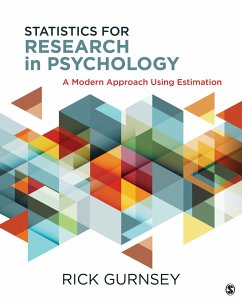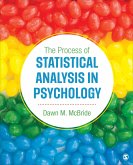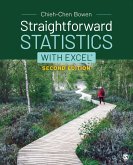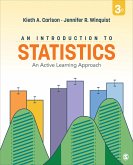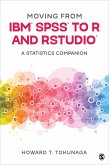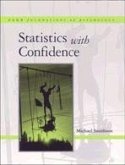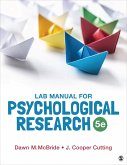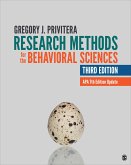- Gebundenes Buch
- Merkliste
- Auf die Merkliste
- Bewerten Bewerten
- Teilen
- Produkt teilen
- Produkterinnerung
- Produkterinnerung
Statistics for Research in Psychology offers an intuitive approach to statistics based on estimation for interpreting research in psychology.
Andere Kunden interessierten sich auch für
![The Process of Statistical Analysis in Psychology The Process of Statistical Analysis in Psychology]() Dawn M. McBrideThe Process of Statistical Analysis in Psychology161,99 €
Dawn M. McBrideThe Process of Statistical Analysis in Psychology161,99 €![Straightforward Statistics with Excel Straightforward Statistics with Excel]() Chieh-Chen BowenStraightforward Statistics with Excel149,99 €
Chieh-Chen BowenStraightforward Statistics with Excel149,99 €![An Introduction to Statistics An Introduction to Statistics]() Kieth Alton CarlsonAn Introduction to Statistics203,99 €
Kieth Alton CarlsonAn Introduction to Statistics203,99 €![Moving from Ibm(r) Spss(r) to R and Rstudio(r) Moving from Ibm(r) Spss(r) to R and Rstudio(r)]() Howard T. TokunagaMoving from Ibm(r) Spss(r) to R and Rstudio(r)52,99 €
Howard T. TokunagaMoving from Ibm(r) Spss(r) to R and Rstudio(r)52,99 €![Statistics with Confidence Statistics with Confidence]() Michael SmithsonStatistics with Confidence88,99 €
Michael SmithsonStatistics with Confidence88,99 €![Lab Manual for Psychological Research Lab Manual for Psychological Research]() Dawn M. McBrideLab Manual for Psychological Research84,99 €
Dawn M. McBrideLab Manual for Psychological Research84,99 €![Research Methods for the Behavioral Sciences Research Methods for the Behavioral Sciences]() Gregory J. Privitera (St. Bonaventure University)Research Methods for the Behavioral Sciences192,99 €
Gregory J. Privitera (St. Bonaventure University)Research Methods for the Behavioral Sciences192,99 €-
-
-
Statistics for Research in Psychology offers an intuitive approach to statistics based on estimation for interpreting research in psychology.
Hinweis: Dieser Artikel kann nur an eine deutsche Lieferadresse ausgeliefert werden.
Hinweis: Dieser Artikel kann nur an eine deutsche Lieferadresse ausgeliefert werden.
Produktdetails
- Produktdetails
- Verlag: SAGE Publications Inc
- Seitenzahl: 720
- Erscheinungstermin: 21. September 2017
- Englisch
- Abmessung: 259mm x 211mm x 33mm
- Gewicht: 1470g
- ISBN-13: 9781506305189
- ISBN-10: 1506305180
- Artikelnr.: 47876853
- Herstellerkennzeichnung
- Libri GmbH
- Europaallee 1
- 36244 Bad Hersfeld
- gpsr@libri.de
- Verlag: SAGE Publications Inc
- Seitenzahl: 720
- Erscheinungstermin: 21. September 2017
- Englisch
- Abmessung: 259mm x 211mm x 33mm
- Gewicht: 1470g
- ISBN-13: 9781506305189
- ISBN-10: 1506305180
- Artikelnr.: 47876853
- Herstellerkennzeichnung
- Libri GmbH
- Europaallee 1
- 36244 Bad Hersfeld
- gpsr@libri.de
Preface Acknowledgments About the Author PART I
INTRODUCTION TO STATISTICS AND STATISTICAL DISTRIBUTIONS Chapter 1
Basic Concepts Statistics in Psychology Variables, Values, and Scores Measurement Populations and Samples Sampling, Sampling Bias, and Sampling Error A Preview of What's Ahead Summary Key Terms Exercises Appendix 1.1: Introduction to Excel Appendix 1.2: Introduction to SPSS Appendix 1.3: An Introduction to R Chapter 2
Distributions of Scores Introduction Distributions of Qualitative Variables Distributions of Discrete Quantitative Variables Distributions of Continuous Variables Probability Probability Distributions Summary Key Terms Exercises Appendix 2.1: Grouped Frequency Tables and Histograms in Excel Appendix 2.2: Grouped Frequency Tables and Histograms in SPSS Chapter 3
Properties of Distributions Introduction Central Tendency Dispersion (Spread) Shape Summary Key Terms Exercises Appendix 3.1: Basic Statistics in Excel Appendix 3.2: Basic Statistics in SPSS Chapter 4
Normal Distributions Introduction Normal Distributions The Standard Normal Distribution: z-Scores Area-Under-the-Curve Problems: Approximate Solutions The z-Table Area-Under-the-Curve Problems: Exact Solutions Critical Value Problems Applications Summary Key Terms Exercises Appendix 4.1: NORM.DIST and Related Functions in Excel Chapter 5
Distributions of Statistics Introduction The Distribution of Sample Means Area-Under-the-Curve Questions Critical Value Problems The Distribution of Sample Variances Summary Key Terms Exercises Appendix 5.1: Statistical Distribution Functions in Excel PART II
ESTIMATION AND SIGNIFICANCE TESTS (ONE SAMPLE) Chapter 6
Estimating the Population Mean When the Population Standard Deviation Is Known Introduction An Example Point Estimates Versus Interval Estimates 95% Confidence Intervals (1-a)100% Confidence Intervals Cautions About Interpretation Estimating µ When Sample Size Is Large Assumptions Planning a Study A Word About Jerzy Neyman Summary Key Terms Exercises Appendix 6.1: Computing Confidence Intervals in Excel Chapter 7
Significance Tests Introduction A Scenario: Whole Language Versus Phonics Significance Tests Computing Exact p-Values: Directional and Non-directional Tests The Alternative Hypothesis p-Values Are Conditional Probabilities Using s to Estimate s (An Approximate z-Test) Statistical Significance Versus Practical Significance Review of Significance Tests Summary Key Terms Exercises Appendix 7.1: Significance Tests in Excel Chapter 8
Decisions, Power, Effect Size, and the Hybrid Model Introduction Statistical Decisions Neyman and Pearson The Determinants of Power Prospective Power Analysis: Planning Experiments Interpreting Effect Size The Hybrid Model: Null Hypothesis Significance Testing Summary Key Terms Exercises Chapter 9
Significance Tests: Problems and Alternatives Introduction Significance Tests Under Fire Criticisms of Significance Tests Confidence Intervals Estimating µ1 - µ0 Estimating d = (µ1 - µ0)/s Estimation Versus Significance Testing Summary Key Terms Exercises Chapter 10
Estimating the Population Mean When the Standard Deviation Is Unknown Introduction t-Scores: sm Versus sm t-Distributions Confidence Intervals: Estimating µ An Example Estimating the Difference Between Two Population Means Estimating d Significance Tests Summary Key Terms Exercises Appendix 10.1: Confidence Intervals and Significance Tests in Excel Appendix 10.2: Confidence Intervals and Significance Tests in SPSS Appendix 10.3: Exact Confidence Intervals for d Using MBESS in R PART III
ESTIMATION AND SIGNIFICANCE TESTS (TWO SAMPLES) Chapter 11
Estimating the Difference Between the Means of Independent Populations Introduction The Two-Independent-Groups Design An Example Theoretical Foundations for the (1-a)100% Confidence Interval for µ1 - µ2 Effect Size d Significance Testing Interpretation of Our Riddle Study Partitioning Variance Meta-Analysis Summary Key Terms Exercises Appendix 11.1: Estimation and Significance Tests in Excel Appendix 11.2: Estimation and Significance Tests in SPSS Chapter 12
Estimating the Difference Between the Means of Dependent Populations Introduction Dependent Versus Independent Populations The Distributions of D and mD Repeated Measures and Matched Samples Estimating d for Dependent Populations Significance Testing Partitioning Variance Summary Key Terms Exercises Appendix 12.1: Estimation and Significance Tests in Excel Appendix 12.2: Estimation and Significance Tests in SPSS Chapter 13
Introduction to Correlation and Regression Introduction Associations Between Two Scale Variables Correlation and Regression The Correlation Coefficient The Regression Equation Many Bivariate Distributions Have the Same Statistics Random Variables, Experiments, and Causation Summary Key Terms Exercises Appendix 13.1: Correlation and Regression in Excel Chapter 14
Inferential Statistics for Simple Linear Regression Introduction Regression When Values of x Are Fixed: Theory Regression When x Values Are Fixed: An Example Regression When x Is a Random Variable Regression When x Is a Random Variable: An Example Estimating the Expected Value of y: E(y x) Prediction Intervals Summary Key Terms Exercises Appendix 14.1: Inferential Statistics for Regression in Excel Appendix 14.2: Inferential Statistics for Regression in SPSS Chapter 15
Inferential Statistics for Correlation Introduction An Example The Sampling Distribution of r Significance Tests What Is a Big Correlation and What Is the Practical Significance of r? The Correlation Coefficient Is a Standardized Effect Size: Meta-Analysis The Generality of Correlation Summary Key Terms Exercises Appendix 15.1: Correlation Analysis in Excel Appendix 15.2: Correlation Analysis in SPSS PART IV
THE GENERAL LINEAR MODEL Chapter 16
Introduction to Multiple Regression Introduction An Example Parameters and Statistics in Multiple Regression Significance Tests Using SPSS to Conduct Multiple Regression Degrees of Freedom Comparing Regression Models Confidence Intervals for y
and Prediction Intervals for yNEXT Discussion of Our Example: To Add TIE or Not to Add TIE Summary Key Terms Exercises Appendix 16.1: Bootstrapped Confidence Intervals for ?R2 Chapter 17
Applying Multiple Regression Introduction The Regression Coefficients Statistical Control Mediation Moderation Summary Key Terms Exercises Appendix 17.1: Installing the PROCESS Macro in SPSS Chapter 18
Analysis of Variance: One-Factor Between-Subjects Introduction The One-Factor, Between-Subjects ANOVA Planned Contrasts Sources of Variance Trend Analysis Corrections for Multiple Contrasts Regression and ANOVA Are the Same Thing Power Summary Key Terms Exercises Chapter 19
Analysis of Variance: One-Factor Within-Subjects Introduction An Example: The Posner Cuing Task The Omnibus Analysis Confidence Intervals and Significance Tests for Contrasts Conducting the One-Factor Within-Subjects ANOVA in SPSS Summary Key Terms Exercises Chapter 20
Two-Factor ANOVA: Omnibus Effects Introduction Main Effects and Interactions in a 3 × 4 Design Partitioning Variability Among Means: Orthogonal Decomposition An Example: The Texture Discrimination Task The Two-Factor Between-Subjects Design The Two-Factor Within-Subjects Design The Two-Factor Mixed Design Unequal Sample Sizes and Missing Data Why Bother With Main Effects and Interactions? Summary Key Terms Exercises Chapter 21
Contrasts in Two-Factor Designs Introduction An Overview of First-Order and Second-Order (Interaction) Contrasts The Two-Factor, Between-Subjects Design The Two-Factor, Within-Subjects Design The Two-Factor Mixed Design Summary Key Terms Exercises Selected Answers to Chapter Exercises Appendix A Appendix B Appendix C Appendix D Glossary References Index
INTRODUCTION TO STATISTICS AND STATISTICAL DISTRIBUTIONS Chapter 1
Basic Concepts Statistics in Psychology Variables, Values, and Scores Measurement Populations and Samples Sampling, Sampling Bias, and Sampling Error A Preview of What's Ahead Summary Key Terms Exercises Appendix 1.1: Introduction to Excel Appendix 1.2: Introduction to SPSS Appendix 1.3: An Introduction to R Chapter 2
Distributions of Scores Introduction Distributions of Qualitative Variables Distributions of Discrete Quantitative Variables Distributions of Continuous Variables Probability Probability Distributions Summary Key Terms Exercises Appendix 2.1: Grouped Frequency Tables and Histograms in Excel Appendix 2.2: Grouped Frequency Tables and Histograms in SPSS Chapter 3
Properties of Distributions Introduction Central Tendency Dispersion (Spread) Shape Summary Key Terms Exercises Appendix 3.1: Basic Statistics in Excel Appendix 3.2: Basic Statistics in SPSS Chapter 4
Normal Distributions Introduction Normal Distributions The Standard Normal Distribution: z-Scores Area-Under-the-Curve Problems: Approximate Solutions The z-Table Area-Under-the-Curve Problems: Exact Solutions Critical Value Problems Applications Summary Key Terms Exercises Appendix 4.1: NORM.DIST and Related Functions in Excel Chapter 5
Distributions of Statistics Introduction The Distribution of Sample Means Area-Under-the-Curve Questions Critical Value Problems The Distribution of Sample Variances Summary Key Terms Exercises Appendix 5.1: Statistical Distribution Functions in Excel PART II
ESTIMATION AND SIGNIFICANCE TESTS (ONE SAMPLE) Chapter 6
Estimating the Population Mean When the Population Standard Deviation Is Known Introduction An Example Point Estimates Versus Interval Estimates 95% Confidence Intervals (1-a)100% Confidence Intervals Cautions About Interpretation Estimating µ When Sample Size Is Large Assumptions Planning a Study A Word About Jerzy Neyman Summary Key Terms Exercises Appendix 6.1: Computing Confidence Intervals in Excel Chapter 7
Significance Tests Introduction A Scenario: Whole Language Versus Phonics Significance Tests Computing Exact p-Values: Directional and Non-directional Tests The Alternative Hypothesis p-Values Are Conditional Probabilities Using s to Estimate s (An Approximate z-Test) Statistical Significance Versus Practical Significance Review of Significance Tests Summary Key Terms Exercises Appendix 7.1: Significance Tests in Excel Chapter 8
Decisions, Power, Effect Size, and the Hybrid Model Introduction Statistical Decisions Neyman and Pearson The Determinants of Power Prospective Power Analysis: Planning Experiments Interpreting Effect Size The Hybrid Model: Null Hypothesis Significance Testing Summary Key Terms Exercises Chapter 9
Significance Tests: Problems and Alternatives Introduction Significance Tests Under Fire Criticisms of Significance Tests Confidence Intervals Estimating µ1 - µ0 Estimating d = (µ1 - µ0)/s Estimation Versus Significance Testing Summary Key Terms Exercises Chapter 10
Estimating the Population Mean When the Standard Deviation Is Unknown Introduction t-Scores: sm Versus sm t-Distributions Confidence Intervals: Estimating µ An Example Estimating the Difference Between Two Population Means Estimating d Significance Tests Summary Key Terms Exercises Appendix 10.1: Confidence Intervals and Significance Tests in Excel Appendix 10.2: Confidence Intervals and Significance Tests in SPSS Appendix 10.3: Exact Confidence Intervals for d Using MBESS in R PART III
ESTIMATION AND SIGNIFICANCE TESTS (TWO SAMPLES) Chapter 11
Estimating the Difference Between the Means of Independent Populations Introduction The Two-Independent-Groups Design An Example Theoretical Foundations for the (1-a)100% Confidence Interval for µ1 - µ2 Effect Size d Significance Testing Interpretation of Our Riddle Study Partitioning Variance Meta-Analysis Summary Key Terms Exercises Appendix 11.1: Estimation and Significance Tests in Excel Appendix 11.2: Estimation and Significance Tests in SPSS Chapter 12
Estimating the Difference Between the Means of Dependent Populations Introduction Dependent Versus Independent Populations The Distributions of D and mD Repeated Measures and Matched Samples Estimating d for Dependent Populations Significance Testing Partitioning Variance Summary Key Terms Exercises Appendix 12.1: Estimation and Significance Tests in Excel Appendix 12.2: Estimation and Significance Tests in SPSS Chapter 13
Introduction to Correlation and Regression Introduction Associations Between Two Scale Variables Correlation and Regression The Correlation Coefficient The Regression Equation Many Bivariate Distributions Have the Same Statistics Random Variables, Experiments, and Causation Summary Key Terms Exercises Appendix 13.1: Correlation and Regression in Excel Chapter 14
Inferential Statistics for Simple Linear Regression Introduction Regression When Values of x Are Fixed: Theory Regression When x Values Are Fixed: An Example Regression When x Is a Random Variable Regression When x Is a Random Variable: An Example Estimating the Expected Value of y: E(y x) Prediction Intervals Summary Key Terms Exercises Appendix 14.1: Inferential Statistics for Regression in Excel Appendix 14.2: Inferential Statistics for Regression in SPSS Chapter 15
Inferential Statistics for Correlation Introduction An Example The Sampling Distribution of r Significance Tests What Is a Big Correlation and What Is the Practical Significance of r? The Correlation Coefficient Is a Standardized Effect Size: Meta-Analysis The Generality of Correlation Summary Key Terms Exercises Appendix 15.1: Correlation Analysis in Excel Appendix 15.2: Correlation Analysis in SPSS PART IV
THE GENERAL LINEAR MODEL Chapter 16
Introduction to Multiple Regression Introduction An Example Parameters and Statistics in Multiple Regression Significance Tests Using SPSS to Conduct Multiple Regression Degrees of Freedom Comparing Regression Models Confidence Intervals for y
and Prediction Intervals for yNEXT Discussion of Our Example: To Add TIE or Not to Add TIE Summary Key Terms Exercises Appendix 16.1: Bootstrapped Confidence Intervals for ?R2 Chapter 17
Applying Multiple Regression Introduction The Regression Coefficients Statistical Control Mediation Moderation Summary Key Terms Exercises Appendix 17.1: Installing the PROCESS Macro in SPSS Chapter 18
Analysis of Variance: One-Factor Between-Subjects Introduction The One-Factor, Between-Subjects ANOVA Planned Contrasts Sources of Variance Trend Analysis Corrections for Multiple Contrasts Regression and ANOVA Are the Same Thing Power Summary Key Terms Exercises Chapter 19
Analysis of Variance: One-Factor Within-Subjects Introduction An Example: The Posner Cuing Task The Omnibus Analysis Confidence Intervals and Significance Tests for Contrasts Conducting the One-Factor Within-Subjects ANOVA in SPSS Summary Key Terms Exercises Chapter 20
Two-Factor ANOVA: Omnibus Effects Introduction Main Effects and Interactions in a 3 × 4 Design Partitioning Variability Among Means: Orthogonal Decomposition An Example: The Texture Discrimination Task The Two-Factor Between-Subjects Design The Two-Factor Within-Subjects Design The Two-Factor Mixed Design Unequal Sample Sizes and Missing Data Why Bother With Main Effects and Interactions? Summary Key Terms Exercises Chapter 21
Contrasts in Two-Factor Designs Introduction An Overview of First-Order and Second-Order (Interaction) Contrasts The Two-Factor, Between-Subjects Design The Two-Factor, Within-Subjects Design The Two-Factor Mixed Design Summary Key Terms Exercises Selected Answers to Chapter Exercises Appendix A Appendix B Appendix C Appendix D Glossary References Index
Preface Acknowledgments About the Author PART I
INTRODUCTION TO STATISTICS AND STATISTICAL DISTRIBUTIONS Chapter 1
Basic Concepts Statistics in Psychology Variables, Values, and Scores Measurement Populations and Samples Sampling, Sampling Bias, and Sampling Error A Preview of What's Ahead Summary Key Terms Exercises Appendix 1.1: Introduction to Excel Appendix 1.2: Introduction to SPSS Appendix 1.3: An Introduction to R Chapter 2
Distributions of Scores Introduction Distributions of Qualitative Variables Distributions of Discrete Quantitative Variables Distributions of Continuous Variables Probability Probability Distributions Summary Key Terms Exercises Appendix 2.1: Grouped Frequency Tables and Histograms in Excel Appendix 2.2: Grouped Frequency Tables and Histograms in SPSS Chapter 3
Properties of Distributions Introduction Central Tendency Dispersion (Spread) Shape Summary Key Terms Exercises Appendix 3.1: Basic Statistics in Excel Appendix 3.2: Basic Statistics in SPSS Chapter 4
Normal Distributions Introduction Normal Distributions The Standard Normal Distribution: z-Scores Area-Under-the-Curve Problems: Approximate Solutions The z-Table Area-Under-the-Curve Problems: Exact Solutions Critical Value Problems Applications Summary Key Terms Exercises Appendix 4.1: NORM.DIST and Related Functions in Excel Chapter 5
Distributions of Statistics Introduction The Distribution of Sample Means Area-Under-the-Curve Questions Critical Value Problems The Distribution of Sample Variances Summary Key Terms Exercises Appendix 5.1: Statistical Distribution Functions in Excel PART II
ESTIMATION AND SIGNIFICANCE TESTS (ONE SAMPLE) Chapter 6
Estimating the Population Mean When the Population Standard Deviation Is Known Introduction An Example Point Estimates Versus Interval Estimates 95% Confidence Intervals (1-a)100% Confidence Intervals Cautions About Interpretation Estimating µ When Sample Size Is Large Assumptions Planning a Study A Word About Jerzy Neyman Summary Key Terms Exercises Appendix 6.1: Computing Confidence Intervals in Excel Chapter 7
Significance Tests Introduction A Scenario: Whole Language Versus Phonics Significance Tests Computing Exact p-Values: Directional and Non-directional Tests The Alternative Hypothesis p-Values Are Conditional Probabilities Using s to Estimate s (An Approximate z-Test) Statistical Significance Versus Practical Significance Review of Significance Tests Summary Key Terms Exercises Appendix 7.1: Significance Tests in Excel Chapter 8
Decisions, Power, Effect Size, and the Hybrid Model Introduction Statistical Decisions Neyman and Pearson The Determinants of Power Prospective Power Analysis: Planning Experiments Interpreting Effect Size The Hybrid Model: Null Hypothesis Significance Testing Summary Key Terms Exercises Chapter 9
Significance Tests: Problems and Alternatives Introduction Significance Tests Under Fire Criticisms of Significance Tests Confidence Intervals Estimating µ1 - µ0 Estimating d = (µ1 - µ0)/s Estimation Versus Significance Testing Summary Key Terms Exercises Chapter 10
Estimating the Population Mean When the Standard Deviation Is Unknown Introduction t-Scores: sm Versus sm t-Distributions Confidence Intervals: Estimating µ An Example Estimating the Difference Between Two Population Means Estimating d Significance Tests Summary Key Terms Exercises Appendix 10.1: Confidence Intervals and Significance Tests in Excel Appendix 10.2: Confidence Intervals and Significance Tests in SPSS Appendix 10.3: Exact Confidence Intervals for d Using MBESS in R PART III
ESTIMATION AND SIGNIFICANCE TESTS (TWO SAMPLES) Chapter 11
Estimating the Difference Between the Means of Independent Populations Introduction The Two-Independent-Groups Design An Example Theoretical Foundations for the (1-a)100% Confidence Interval for µ1 - µ2 Effect Size d Significance Testing Interpretation of Our Riddle Study Partitioning Variance Meta-Analysis Summary Key Terms Exercises Appendix 11.1: Estimation and Significance Tests in Excel Appendix 11.2: Estimation and Significance Tests in SPSS Chapter 12
Estimating the Difference Between the Means of Dependent Populations Introduction Dependent Versus Independent Populations The Distributions of D and mD Repeated Measures and Matched Samples Estimating d for Dependent Populations Significance Testing Partitioning Variance Summary Key Terms Exercises Appendix 12.1: Estimation and Significance Tests in Excel Appendix 12.2: Estimation and Significance Tests in SPSS Chapter 13
Introduction to Correlation and Regression Introduction Associations Between Two Scale Variables Correlation and Regression The Correlation Coefficient The Regression Equation Many Bivariate Distributions Have the Same Statistics Random Variables, Experiments, and Causation Summary Key Terms Exercises Appendix 13.1: Correlation and Regression in Excel Chapter 14
Inferential Statistics for Simple Linear Regression Introduction Regression When Values of x Are Fixed: Theory Regression When x Values Are Fixed: An Example Regression When x Is a Random Variable Regression When x Is a Random Variable: An Example Estimating the Expected Value of y: E(y x) Prediction Intervals Summary Key Terms Exercises Appendix 14.1: Inferential Statistics for Regression in Excel Appendix 14.2: Inferential Statistics for Regression in SPSS Chapter 15
Inferential Statistics for Correlation Introduction An Example The Sampling Distribution of r Significance Tests What Is a Big Correlation and What Is the Practical Significance of r? The Correlation Coefficient Is a Standardized Effect Size: Meta-Analysis The Generality of Correlation Summary Key Terms Exercises Appendix 15.1: Correlation Analysis in Excel Appendix 15.2: Correlation Analysis in SPSS PART IV
THE GENERAL LINEAR MODEL Chapter 16
Introduction to Multiple Regression Introduction An Example Parameters and Statistics in Multiple Regression Significance Tests Using SPSS to Conduct Multiple Regression Degrees of Freedom Comparing Regression Models Confidence Intervals for y
and Prediction Intervals for yNEXT Discussion of Our Example: To Add TIE or Not to Add TIE Summary Key Terms Exercises Appendix 16.1: Bootstrapped Confidence Intervals for ?R2 Chapter 17
Applying Multiple Regression Introduction The Regression Coefficients Statistical Control Mediation Moderation Summary Key Terms Exercises Appendix 17.1: Installing the PROCESS Macro in SPSS Chapter 18
Analysis of Variance: One-Factor Between-Subjects Introduction The One-Factor, Between-Subjects ANOVA Planned Contrasts Sources of Variance Trend Analysis Corrections for Multiple Contrasts Regression and ANOVA Are the Same Thing Power Summary Key Terms Exercises Chapter 19
Analysis of Variance: One-Factor Within-Subjects Introduction An Example: The Posner Cuing Task The Omnibus Analysis Confidence Intervals and Significance Tests for Contrasts Conducting the One-Factor Within-Subjects ANOVA in SPSS Summary Key Terms Exercises Chapter 20
Two-Factor ANOVA: Omnibus Effects Introduction Main Effects and Interactions in a 3 × 4 Design Partitioning Variability Among Means: Orthogonal Decomposition An Example: The Texture Discrimination Task The Two-Factor Between-Subjects Design The Two-Factor Within-Subjects Design The Two-Factor Mixed Design Unequal Sample Sizes and Missing Data Why Bother With Main Effects and Interactions? Summary Key Terms Exercises Chapter 21
Contrasts in Two-Factor Designs Introduction An Overview of First-Order and Second-Order (Interaction) Contrasts The Two-Factor, Between-Subjects Design The Two-Factor, Within-Subjects Design The Two-Factor Mixed Design Summary Key Terms Exercises Selected Answers to Chapter Exercises Appendix A Appendix B Appendix C Appendix D Glossary References Index
INTRODUCTION TO STATISTICS AND STATISTICAL DISTRIBUTIONS Chapter 1
Basic Concepts Statistics in Psychology Variables, Values, and Scores Measurement Populations and Samples Sampling, Sampling Bias, and Sampling Error A Preview of What's Ahead Summary Key Terms Exercises Appendix 1.1: Introduction to Excel Appendix 1.2: Introduction to SPSS Appendix 1.3: An Introduction to R Chapter 2
Distributions of Scores Introduction Distributions of Qualitative Variables Distributions of Discrete Quantitative Variables Distributions of Continuous Variables Probability Probability Distributions Summary Key Terms Exercises Appendix 2.1: Grouped Frequency Tables and Histograms in Excel Appendix 2.2: Grouped Frequency Tables and Histograms in SPSS Chapter 3
Properties of Distributions Introduction Central Tendency Dispersion (Spread) Shape Summary Key Terms Exercises Appendix 3.1: Basic Statistics in Excel Appendix 3.2: Basic Statistics in SPSS Chapter 4
Normal Distributions Introduction Normal Distributions The Standard Normal Distribution: z-Scores Area-Under-the-Curve Problems: Approximate Solutions The z-Table Area-Under-the-Curve Problems: Exact Solutions Critical Value Problems Applications Summary Key Terms Exercises Appendix 4.1: NORM.DIST and Related Functions in Excel Chapter 5
Distributions of Statistics Introduction The Distribution of Sample Means Area-Under-the-Curve Questions Critical Value Problems The Distribution of Sample Variances Summary Key Terms Exercises Appendix 5.1: Statistical Distribution Functions in Excel PART II
ESTIMATION AND SIGNIFICANCE TESTS (ONE SAMPLE) Chapter 6
Estimating the Population Mean When the Population Standard Deviation Is Known Introduction An Example Point Estimates Versus Interval Estimates 95% Confidence Intervals (1-a)100% Confidence Intervals Cautions About Interpretation Estimating µ When Sample Size Is Large Assumptions Planning a Study A Word About Jerzy Neyman Summary Key Terms Exercises Appendix 6.1: Computing Confidence Intervals in Excel Chapter 7
Significance Tests Introduction A Scenario: Whole Language Versus Phonics Significance Tests Computing Exact p-Values: Directional and Non-directional Tests The Alternative Hypothesis p-Values Are Conditional Probabilities Using s to Estimate s (An Approximate z-Test) Statistical Significance Versus Practical Significance Review of Significance Tests Summary Key Terms Exercises Appendix 7.1: Significance Tests in Excel Chapter 8
Decisions, Power, Effect Size, and the Hybrid Model Introduction Statistical Decisions Neyman and Pearson The Determinants of Power Prospective Power Analysis: Planning Experiments Interpreting Effect Size The Hybrid Model: Null Hypothesis Significance Testing Summary Key Terms Exercises Chapter 9
Significance Tests: Problems and Alternatives Introduction Significance Tests Under Fire Criticisms of Significance Tests Confidence Intervals Estimating µ1 - µ0 Estimating d = (µ1 - µ0)/s Estimation Versus Significance Testing Summary Key Terms Exercises Chapter 10
Estimating the Population Mean When the Standard Deviation Is Unknown Introduction t-Scores: sm Versus sm t-Distributions Confidence Intervals: Estimating µ An Example Estimating the Difference Between Two Population Means Estimating d Significance Tests Summary Key Terms Exercises Appendix 10.1: Confidence Intervals and Significance Tests in Excel Appendix 10.2: Confidence Intervals and Significance Tests in SPSS Appendix 10.3: Exact Confidence Intervals for d Using MBESS in R PART III
ESTIMATION AND SIGNIFICANCE TESTS (TWO SAMPLES) Chapter 11
Estimating the Difference Between the Means of Independent Populations Introduction The Two-Independent-Groups Design An Example Theoretical Foundations for the (1-a)100% Confidence Interval for µ1 - µ2 Effect Size d Significance Testing Interpretation of Our Riddle Study Partitioning Variance Meta-Analysis Summary Key Terms Exercises Appendix 11.1: Estimation and Significance Tests in Excel Appendix 11.2: Estimation and Significance Tests in SPSS Chapter 12
Estimating the Difference Between the Means of Dependent Populations Introduction Dependent Versus Independent Populations The Distributions of D and mD Repeated Measures and Matched Samples Estimating d for Dependent Populations Significance Testing Partitioning Variance Summary Key Terms Exercises Appendix 12.1: Estimation and Significance Tests in Excel Appendix 12.2: Estimation and Significance Tests in SPSS Chapter 13
Introduction to Correlation and Regression Introduction Associations Between Two Scale Variables Correlation and Regression The Correlation Coefficient The Regression Equation Many Bivariate Distributions Have the Same Statistics Random Variables, Experiments, and Causation Summary Key Terms Exercises Appendix 13.1: Correlation and Regression in Excel Chapter 14
Inferential Statistics for Simple Linear Regression Introduction Regression When Values of x Are Fixed: Theory Regression When x Values Are Fixed: An Example Regression When x Is a Random Variable Regression When x Is a Random Variable: An Example Estimating the Expected Value of y: E(y x) Prediction Intervals Summary Key Terms Exercises Appendix 14.1: Inferential Statistics for Regression in Excel Appendix 14.2: Inferential Statistics for Regression in SPSS Chapter 15
Inferential Statistics for Correlation Introduction An Example The Sampling Distribution of r Significance Tests What Is a Big Correlation and What Is the Practical Significance of r? The Correlation Coefficient Is a Standardized Effect Size: Meta-Analysis The Generality of Correlation Summary Key Terms Exercises Appendix 15.1: Correlation Analysis in Excel Appendix 15.2: Correlation Analysis in SPSS PART IV
THE GENERAL LINEAR MODEL Chapter 16
Introduction to Multiple Regression Introduction An Example Parameters and Statistics in Multiple Regression Significance Tests Using SPSS to Conduct Multiple Regression Degrees of Freedom Comparing Regression Models Confidence Intervals for y
and Prediction Intervals for yNEXT Discussion of Our Example: To Add TIE or Not to Add TIE Summary Key Terms Exercises Appendix 16.1: Bootstrapped Confidence Intervals for ?R2 Chapter 17
Applying Multiple Regression Introduction The Regression Coefficients Statistical Control Mediation Moderation Summary Key Terms Exercises Appendix 17.1: Installing the PROCESS Macro in SPSS Chapter 18
Analysis of Variance: One-Factor Between-Subjects Introduction The One-Factor, Between-Subjects ANOVA Planned Contrasts Sources of Variance Trend Analysis Corrections for Multiple Contrasts Regression and ANOVA Are the Same Thing Power Summary Key Terms Exercises Chapter 19
Analysis of Variance: One-Factor Within-Subjects Introduction An Example: The Posner Cuing Task The Omnibus Analysis Confidence Intervals and Significance Tests for Contrasts Conducting the One-Factor Within-Subjects ANOVA in SPSS Summary Key Terms Exercises Chapter 20
Two-Factor ANOVA: Omnibus Effects Introduction Main Effects and Interactions in a 3 × 4 Design Partitioning Variability Among Means: Orthogonal Decomposition An Example: The Texture Discrimination Task The Two-Factor Between-Subjects Design The Two-Factor Within-Subjects Design The Two-Factor Mixed Design Unequal Sample Sizes and Missing Data Why Bother With Main Effects and Interactions? Summary Key Terms Exercises Chapter 21
Contrasts in Two-Factor Designs Introduction An Overview of First-Order and Second-Order (Interaction) Contrasts The Two-Factor, Between-Subjects Design The Two-Factor, Within-Subjects Design The Two-Factor Mixed Design Summary Key Terms Exercises Selected Answers to Chapter Exercises Appendix A Appendix B Appendix C Appendix D Glossary References Index

